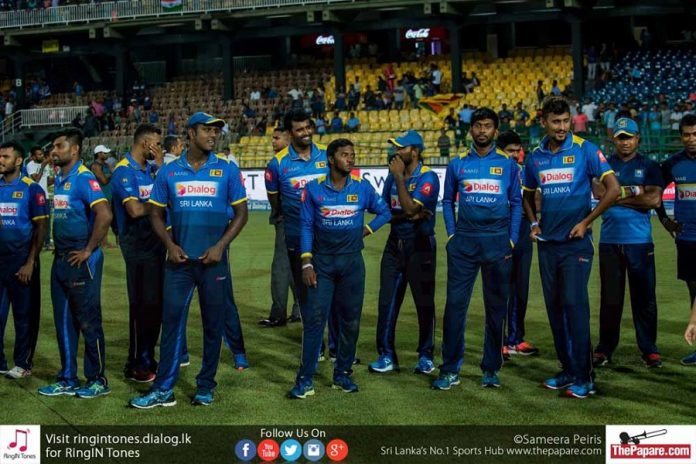Cricket was just a game, sport was just played during weekends, evenings and days off with family and friends, to while away time and entertain. With globalization, Sport has become something which attracts money and has become a medium of marketing goods and services.
This is why you may see things like players wearing sunglasses at night – a sponsorship endorsement.
Free Hit contributor – Thushan Perera
Monetization of sport brought numerous good things to sports. They make sport more scientific and methodological. If you’ve watched movies like Moneyball, you can see how advanced sport really is at the minute.
As nearly everything has bad implications, one of the most dangerous perils brought by monetization is the need it creates in players/all those involved to be successful overnight. This peril has caused a lot of damage to Sri Lanka Cricket in the past 36 months.
Sri Lanka, a tiny island which has more 2500 years of written history and has been divided by racism, conflicts, politics and a number of other things in the last 50-60 years has been united by one thing, Cricket.
Sri Lanka have won only a handful of world events. The first one, as far as I know, was in 1973 by legendary M.J.M Lafir and the 2nd one was in 1996 when Sri Lanka won the Cricket World Cup.
The one in ‘96 was special because 14 semi-professional players, who came from an under-developed or, in more generous words, developing country went all the way through to the final of a world event and won the trophy in style.
I think players in that era had high self-esteem because of a couple of things, patience and persistence. I am not referring to the way they played their cricket. I am talking about the moral they played with. It could be a result of having to wait for most things. If you wanted something during those days from the 1960s to the 2000s, you could not simply buy it right then through an online shopping portal. Instead you’d have to wait until you could go personally and buy it.
Because of a slow-moving world, people learned to wait. The problem today is if we can wait until the magic begins. You have a thousand different competitors instead of the hundred you had 40 years ago. They can run faster than you, they are better equipped than you, it seems like they are much more talented than you too. Can you still play the waiting game?
Many believe that it can and should be done. You might have to sacrifice short term results for more long-term ones.
Sri Lanka has been rebuilding since 2010 and are yet to see established results. If you look back and analyze it carefully, you could see the reason for that. It is ‘Instant gratification’ (the urge to satisfy oneself quickly) instead of the use of ‘Patience and Persistence’. An example of a success story with regards to ‘Instant gratification’ is that of Ajantha Mendis. He was a success story in his early years but by the 2011 World cup, his ‘mystery’ was deciphered and he had nothing to fall back on.
This is most clearly evident in the years after 2010. If you looked at before 2011, Sri Lanka handed out 114 Test caps in 30 years. In contrast, since there was no proper succession plan for the then impending retirements of Muralitharan, Vaas, Jayawardene, Sangakkara, Dilshan, Samaraweera, et al, instead of grooming set of trusted players under them, Sri Lanka has given out 40 Test caps in the last 6/7 years. This tendency was most evident in the years 2015 to 2017.
Because of this failed approach, there are many players who represented Sri Lanka in the recent past who had actually not reached international standards when they made their debuts in international cricket. Some players were rushed into international cricket but were left high and dry after a couple of games. A prime example of this was the case of Avishka Fernando, who holds the record for most runs in Under 19 cricket for Sri Lanka. He made his debut against Australia, having to face Mitchell Starc in his prime straightaway. Avishka was dropped for very next game after getting out for a 2-ball duck.
Sri Lanka was never a team which won games based on big names. Unlike India, who won games through their superstar players Tendulkar, Ganguly, Sehwag, Azharudin, Kumble, Dhoni… etc. Sri Lanka’s success was always based on utility players and team work. Chandana, Dharmasena, Arnold, Kulasekara and Maharoof were the sort of players who gave us a competitive advantage over many other countries. Sri Lanka was a tough side to beat not just because of the big names in it but because of the quality of utility players we had.
After 2011, Sri Lanka tried to become a side like India and focused too much on star power and core players but failed miserably.
Sri Lanka Cricket enjoyed a golden run between 2006-2011. In this period, we could observe how promising players transformed into legends. Sangakkara, Jayawardena, Dilshan, Samaraweera led the batting. Vaas, Malinga and Muralitharan led the bowling. All of a sudden it was the greatest ever Sri Lankan team. But what was behind the greatest ever Sri Lanka team – the results of ‘Patience and Persistence’ with aforementioned names over the years.
Sangakkara was dropped in 2001 over bad form and was hugely criticized over his glove work during the 2003 World Cup particularly as his predecessor Kaluwitharana was a crowd favorite anyway. Jayawardena had a forgettable 2003 World Cup. Dilshan was a fringe player till 2008/09 season. Samaraweera was criticized for his slow batting in his early days. They could have abandoned Muralitharan either in Melbourne in 1995 or Adelaide in 1998/99.
But Sri Lanka persisted with those young guys more often than not and built the greatest ever Sri Lanka XI and reached the 2nd place of the ICC ODI rankings in 2009.
Because of this persistence with a few players in those years, several good domestic players such as Indika de Saram, Jeevantha Kulatunga, Thilina Kandambi and Kaushal Lokuarachchi were overlooked despite good performances. However, when Sri Lanka was looking for replacements for their greats, most of those overlooked players had either retired or were too old or were past their peak. This is due to the lack of quality in domestic cricket. Australia also had the same problem after 2009 but they still had guys like George Bailey, Aaron Finch, Shaun Tait, Brad Haddin who had a good domestic structure to play in.
So, with the new selection panel, coaching staff and leadership group, Sri Lanka Cricket must use their trusted formula for success and get rid of the failed approach of chopping and changing heads for short term results. If not, Sri Lanka will go back to where Sri Lanka started in 1981.
We should remember that we are currently behind Bangladesh. We cannot fall further.
*Disclaimer: The views and opinions expressed in this article are those of the author’s and do not necessarily reflect the official policy or position of ThePapare.com














